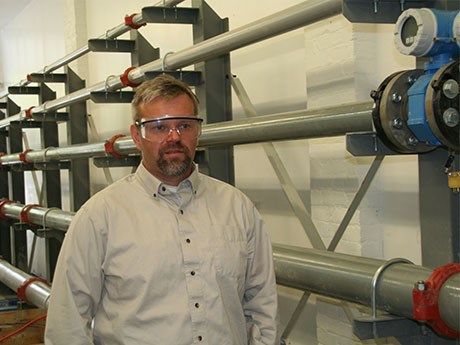Kovit Engineering is the latest in a string of Sudbury mining suppliers to be snapped up by larger global enterprises serving the mining industry.
A leading consulting and engineering company specializing in surface and underground mine tailings solutions, Kovit was acquired in August by Finnish mineral processing giant Outotec.
Kovit was founded by partners Frank Palkovits, Paul Rantala, Steve Reichle and Mark Wallgren in 2011, and in four years had already established a reputation as a global leader in tailings solutions. Winner of the 2015 Northern Ontario Business Export Award, Kovit does business in Russia, Poland, Chile, Ireland, Australia and Africa.
“We weren’t actively looking to be taken over, but Outotec took notice of us because we were growing in a declining economy,” said Rantala.
Outotec will absorb Kovit, but keep it as a regional hub specializing in materials management, high-level studies and the design and construction of backfill and tailings management infrastructure.
Kovit went from four to 30 employees from 2011 to 2015 and expects to bring on eight more employees by the end of the year.
Expertise
Sudbury emerged as a centre of expertise for mine backfill and tailings management in the early 90s when Inco experimented with the technology. The expertise coalesced at Golder Paste Techology Limited under the leadership of Dave Landriault, who had worked at Inco.
A subsidiary of Golder Associates, the PasteTec group emerged as a global leader in backfill solutions and tailings management, taking on projects around the world. However, Landriault’s untimely death in 2007 on a kayak trip in Georgian Bay and the subsequent departure of several other key people, including 10-year veteran Palkovits, left a big hole in the company.
Palkovits teamed up with Rantala, who spent seven years at Inco before going solo as a consultant, Reichle, an electrical engineer and co-founder of Ionic Engineering in Sudbury, and Wallgren, who worked for Hatch specializing in the design of concrete batch plants.
The importance of environmentally sustainable tailings management made headlines around the world in August 2014 when 10 million cubic metres of water and 4.5 million cubic metres of slurry escaped from a tailings dam at the Mount Polley open pit copper and gold mine in British Columbia. Described as one of the worst environmental disasters in Canadian history, the breach brought into focus the value of thickened tailings or dry stack solutions.
Conventional tailings ponds have also come under attack in Alberta’s oilsands as an eyesore and a cause of bird mortality.
“It’s not the latest and greatest way of dealing with tailings,” said Ranatala. “If you deposit it as a higher concentration of solids, you can dry it to a filter cake. There are many reasons why you would go with such a solution, not least of which is to avoid a disaster like the one at Mount Polley.
Best science
“This is what we’ve been preaching. It’s the best science, so when we’re asked to propose a mine backfill solution, we step back and ask, ‘If we design a mine backfill plant, what else can we do?’ Whenever we get involved with a project, we always try to look at the big picture. Sometimes, a client may not know what the best solution is. Maybe what they’re asking us to do is completely wrong.”
With a dewatering plant already in place to produce paste backfill – essentially returning waste rock underground to fill voids and provide structural stability – tailings can be deposited with a higher concentration of solids, resulting in a smaller, dryer footprint that’s easier to contain and remediate.
There are several degrees of dewatering, ranging from slurries and thickened segregating slurries to thickened non-segregating tailings, paste and filter cake.
Kovit offers solutions for all the options based on the principle of mine optimization, said Rantala.
Understanding the material characteristics of a mine waste product is critical to coming up with a solution.
The production of paste is very material dependent, explained Rantala. “That’s why we have a lab onsite. If we’re running a project and selecting equipment for a plant, we have to understand the material characteristics. The lab helps us determine how to thicken tailings and allows us to select a flocculent. It tells us how well it filters and the size and type of filters to use.
“We also have a pump loop to figure out how much power we need, the size of the pipeline and the velocities to be achieved.”
Thickening solutions may cost a bit more,” acknowledged Rantala, “but when you do the math on the revenue that comes out of a high cash flow operation, the cost of the infrastructure is peanuts.”
If a client is concerned about cost, Kovit can also stage a project to spread out the capital spend.
The use of paste backfill has definite advantages over hydraulic fill and cemented rockfill and, in many situations, is the preferred method, said Rantala.
Hydraulic fill is generally of poorer quality due to excess water, and is comparatively slower to place and cure, while cemented rockfill is commonly placed with underground loaders and trucks, which interferes with ore production, adds to ventilation requirements and is hard on equipment.
Cemented rockfill
Cemented rockfill is typically used early in an underground mine’s life when there is excess rock available from development, but is usually not sustainable for the long term.
“Cemented rockfill can make a good backfill, but it impairs profitability,” said Rantala. “If I can drill a hole (for the delivery of paste fill) and build a system that doesn’t interfere with production, in one year it should be possible to extract an extra $10 million of value out of a mine. Then the plant investment is recouped.”
Kovit prospered during its four-year run as an independent consulting firm, but access to Outotec’s resources and global connections is expected to result in more business and opportunities for R&D going forward.



